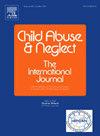技术促进性暴力的潜在阶级分析:与其他受害者、精神症状和性别的关联
IF 3.4
2区 心理学
Q1 FAMILY STUDIES
引用次数: 0
摘要
背景多重受害研究表明,暴力暴露对心理健康的累积有害影响。受害的潜在类别分析(LCA)是一个不断发展的研究领域,揭示了对心理健康特别不利的暴力暴露的特定组合。尽管人们越来越关注技术促进的暴力(TFSV),但它很少被纳入LCA研究。目的调查受害类型,包括技术促进性暴力。参与者和设定横断面调查数据来自16-23岁的瑞典年轻人的代表性样本(N = 3243,平均年龄= 18.20,SD = 0.61)。方法采用r中封装的PoLCA进行潜在类别分析,认为三个类别的模型最适合数据。结果第1类(性多重受害,10.1%)发生包括TFSV在内的各种形式性暴力的概率最高,精神科诊断比例最高(45.2%)。这个班主要由女生组成。第2类(儿童虐待多重受害,14.8%)的特征是身体和心理虐待儿童的概率很高,性别分布均匀。30.6%的学生赞同精神病诊断。第3类(75.1%)是低受害/规范亚组,性别分布均匀,精神病诊断频率低(12.8%)。第一类表现出最高程度的精神症状。结论针对TFSV的预防工作应考虑到一些青少年所处的整个暴力网络。由于TFSV似乎与精神症状和诊断有关,儿童和青少年精神病学服务机构应更多地关注其年轻患者中的这类暴力行为。本文章由计算机程序翻译,如有差异,请以英文原文为准。
A latent class analysis of technology-facilitated sexual violence: Associations to other victimizations, psychiatric symptoms, and gender
Background
Poly-victimization research has shown the cumulative detrimental effects of violence exposure on mental health. Latent Class Analysis (LCA) of victimization is a growing research field uncovering specific combinations of violence exposures particularly negative to mental health. Despite a growing concern of technology-facilitated violence (TFSV), it is scarcely included in LCA studies.
Objectives
Investigating victimization typologies that includes technology facilitated sexual violence.
Participants and setting
Cross-sectional survey data from a representative sample of Swedish young people in the age range of 16–23 (N = 3243, mean age = 18.20, SD = 0.61).
Methods
A Latent Class Analysis was conducted using the package PoLCA in R. A model with three classes was deemed to best fit the data.
Results
Class 1 (sexual polyvictimization, 10.1 %) had high probabilities of all forms of sexual violence including TFSV and the highest proportion of psychiatric diagnosis (45.2 %). This class consisted of mostly girls. Class 2 (child abuse polyvictimization,14.8 %) was characterized by high probabilities of physical and psychological child abuse and had an even gender distribution. 30.6 % of this class endorsed having a psychiatric diagnosis. Class 3 (75.1 %) was a low victimization/normative subgroup with an even gender distribution and a low (12.8 %) frequency of psychiatric diagnosis. Class 1 exhibited the highest levels of psychiatric symptoms.
Conclusions
Prevention efforts targeted against TFSV should consider the whole web of violence that some young people are situated in. Since TFSV seems to be connected to psychiatric symptoms and diagnosis, Child- and Adolescent Psychiatric services should pay more attention to this type of violence among their young patients.
求助全文
通过发布文献求助,成功后即可免费获取论文全文。
去求助
来源期刊

Child Abuse & Neglect
Multiple-
CiteScore
7.40
自引率
10.40%
发文量
397
期刊介绍:
Official Publication of the International Society for Prevention of Child Abuse and Neglect. Child Abuse & Neglect The International Journal, provides an international, multidisciplinary forum on all aspects of child abuse and neglect, with special emphasis on prevention and treatment; the scope extends further to all those aspects of life which either favor or hinder child development. While contributions will primarily be from the fields of psychology, psychiatry, social work, medicine, nursing, law enforcement, legislature, education, and anthropology, the Journal encourages the concerned lay individual and child-oriented advocate organizations to contribute.
 求助内容:
求助内容: 应助结果提醒方式:
应助结果提醒方式:


